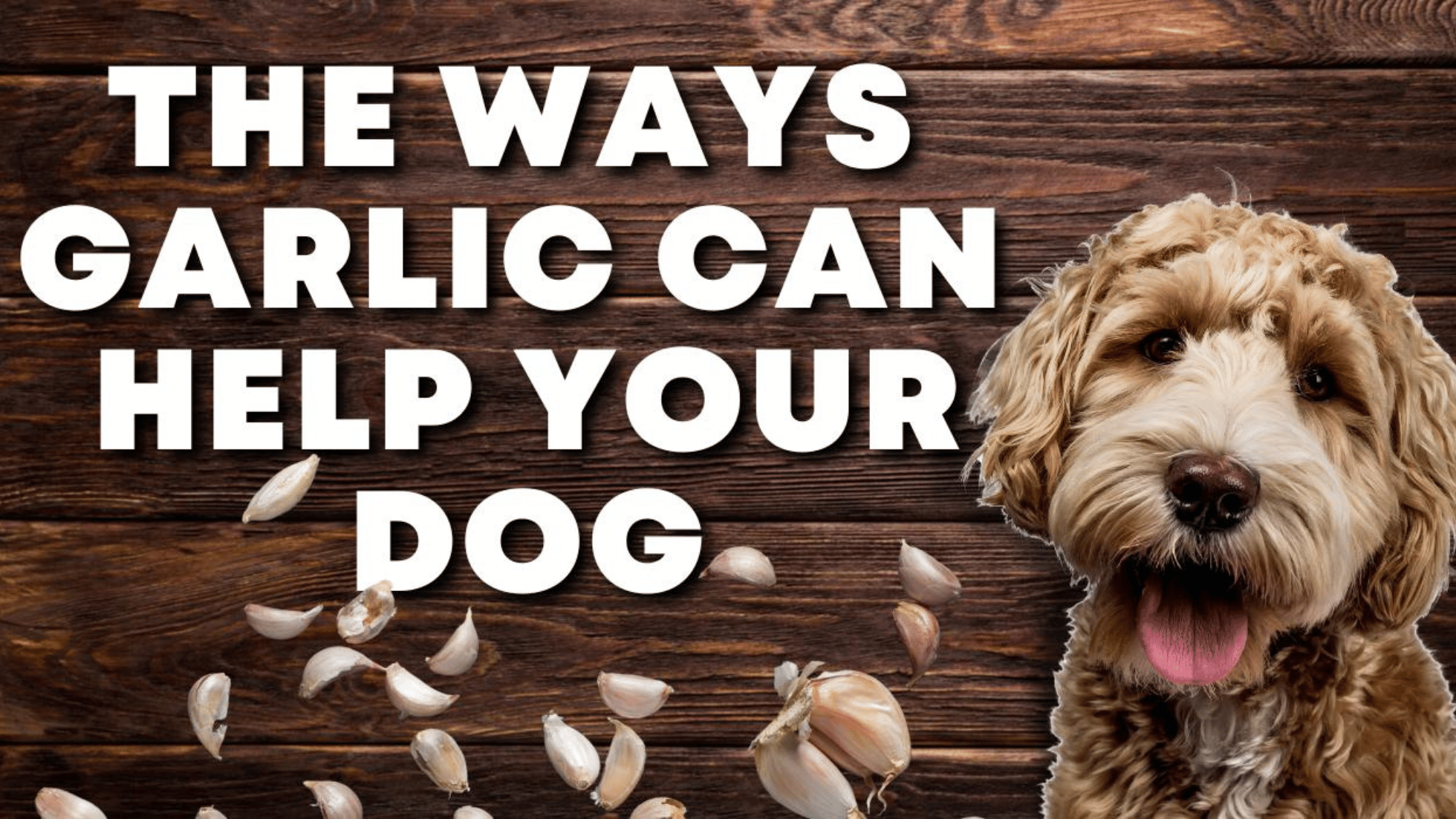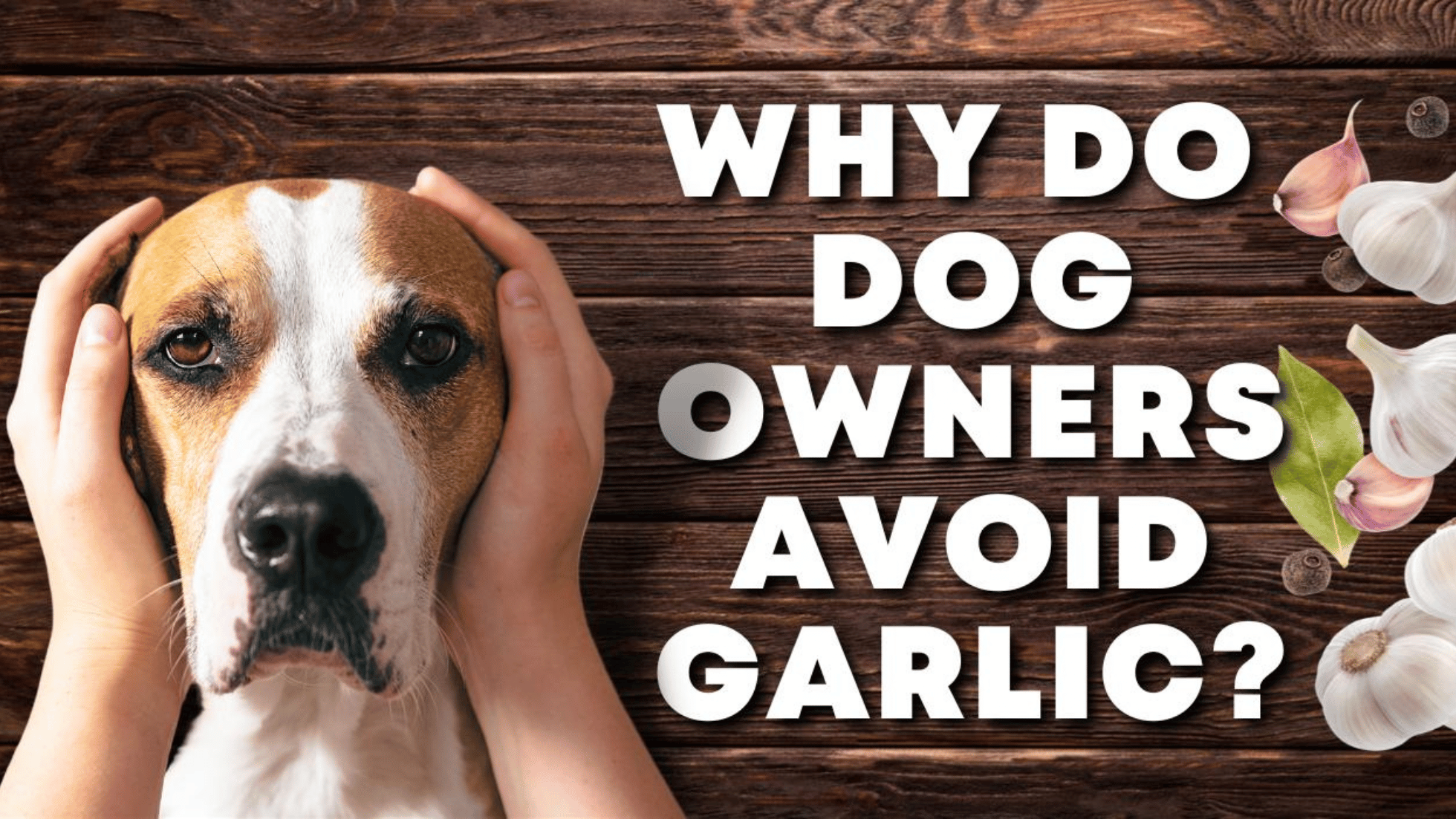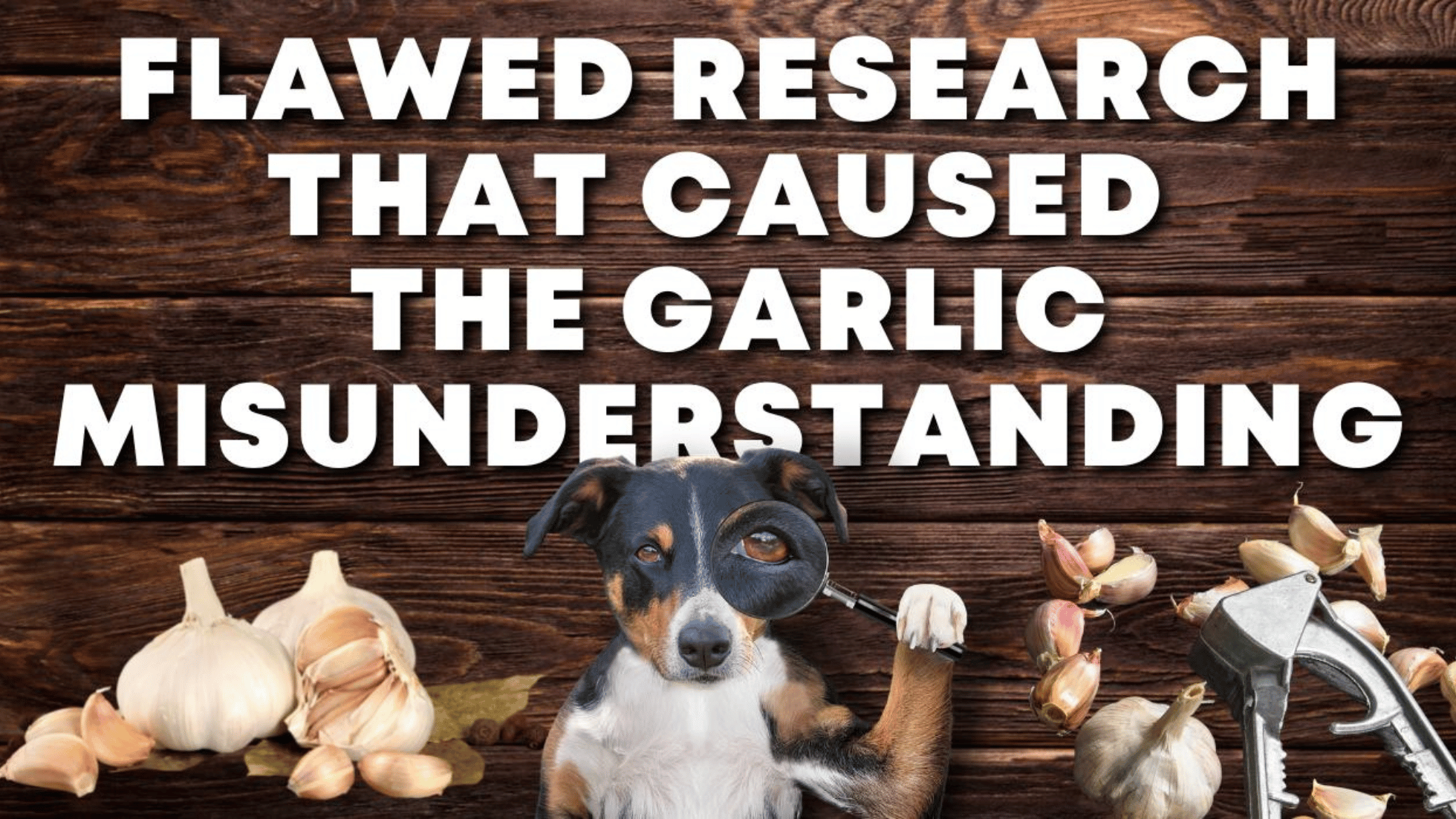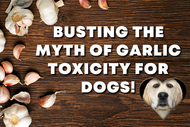Busting the Myth of Garlic Toxicity for Dogs!
Posted by Volhard Dog Nutrition on Oct 7th 2022
If you are scouring the internet, then you have seen countless sites vilifying garlic as a poisonous ingredient for dogs. Unfortunately, there are also vets online and in their offices that have echoed this concern. You are here reading this blog because you do not want to do anything that will harm your dog, and we appreciate the chance to share with you what we have found to be true about dogs and garlic.
Learn and understand the myths surrounding garlic and its supposed toxicity, and discover the many health benefits it offers dogs
The first question is, when there is nothing in the literature to indicate garlic is toxic for canines, how does the popularity of unsubstantiated information proliferate so quickly? The conversation about garlic and dogs is somewhat misleading, and I will tell you why. This misleading information is because most research studies base their findings on the effects of garlic extracts, excessive dosages, and unnatural delivery methods. Researchers rarely use fresh garlic for dogs because measuring variances in whole plant medicine is challenging.
Evidence-based research doesn’t know what to do with the “food as medicine” paradigm.
When it comes to your dogs’ health, whether preventatively or curatively, you need the most up-to-date and accurate information about safety and benefits. Garlic, long used as a beneficial herb, and listed by the FDA as approved for pet food, is still under attack despite a 2004 follow-up study recommending garlic for dogs by the majority of scientists involved in the 2000 study done by Japan. The Japanese study was the catalyst that cultivated garlic’s reputation as a food that can harm your dog. This study by K W Lee et al. fed 5 grams of garlic per kilo per day to the dogs. That’s an excessive amount equivalent to feeding about four full heads of garlic (or 60 cloves) to a 75 lb Golden Retriever or 23 grams of garlic (6 to 8 cloves) to a 10 lb dog before they’d experience any adverse effects. Definitely don’t feed this amount!
Like nettle and turmeric, the evidence suggests that small doses of raw garlic should be medicine for dogs.
What? But the internet and my vet say...
This blog will serve to bust the myth of garlic toxicity for canines by reviewing the following need-to-know information:
- The Ways Garlic Can Help Your Dog
- Why Do Dog Owners Avoid Garlic?
- The Flawed Research That Caused the Garlic Misunderstanding
- How Much Garlic Can Dogs Eat Daily?
- Are Garlic Supplements Just As Beneficial?
- The Preparation of Garlic for Dogs
- Garlic Poisoning
So let’s start with the following: What are the benefits of raw garlic for dogs?
Garlic (Allium sativum) is a vegetable that belongs to the Allium family, the same family as onions, chives, leeks, and shallots ( in there lies much confusion, which we will discuss later).
For centuries, garlic has been used to flavor food and cure various ailments in humans and animals alike. Ancient Egyptians regularly fed garlic to enslaved people to boost their immunity; Chinese doctors and Native Americans frequently used garlic to treat diseases ranging from scurvy to earache.
Garlic is high in inulin, amino acids, sulfur, zinc, potassium, and phosphorus. It also contains vitamins A, C, calcium, magnesium, manganese, selenium, germanium, and B-complex vitamins. While most of these play their role in detoxifying the body, it is the fact garlic contains the bioactive ingredients Allicin and Ajoene that it gets its fame as a near-medicine.
Garlic contains multiple sulfur-inclusive compounds – alliin, a noted sulfoxide; and alliinase, an enzyme. When garlic is chopped, crushed, minced, or chewed, the alliinase enzyme is activated and combines with the alliin protein to produce allicin, the therapeutic component of garlic. Heat inactivates enzymes, so the therapeutic value is maximized by waiting at least ten minutes after chopping, so the enzyme has completed the reaction with the alliin. Allicin is heat stable.
1. How Does Garlic Help Dogs?

arlic’s pungent energy warms the body. Pungent herbs move energy upwards and outwards to the body’s surface, improving circulation. Garlic also has an affinity for the lungs, large intestine, spleen, and stomach.
Garlic helps detoxify the body. Garlic supports beneficial bacteria in the digestive tract while eliminating harmful bacteria. It is great in the fall, winter, and early spring to detox and balances the digestive system.
As a liver enhancer, garlic breaks down wastes before they enter the bloodstream. It also helps the dog assimilate nutrients and eliminate wastes through the entire digestive tract. Garlic is known to have detoxifying effects, which can help the liver get rid of toxins from the body.
The amount of garlic in the Volhard Diets is small but just enough to reap the benefits. We have never had an issue in 40+ years with a dog or health issues related to garlic.
But wait, there’s more…
- Prevents the formation of blood clots (anti-platelet)
- Decreases cholesterol build-up (anticholesterolemic)
- Widens blood vessels (vasodilator)
- Helps prevent the formation of tumors (anti-tumor)
- Stimulates the lymphatic system to remove wastes
- Antibiotic, anti-fungal, and anti-parasitic - Raw garlic (and garlic extracts) are used by the natural veterinary community for their antimicrobial, antiseptic, and antibiotic properties. But of all uses, garlic is perhaps most used as an anthelmintic (deworming agent) for pets.
- Studies have found these compounds to be anti-cancer
Lower blood sugar Lower cholesterol. Most have heard it’s “great for the blood” because it has been used to fight various blood infections and reduce blood pressure.
Garlic has other uses in addition to these health benefits: Garlic as a Flea and Tick Repellent for your dog. The truth of the matter is that fleas prefer weakened animals – the very young, the very old, the sick, and the unhealthy. A flea issue on a healthy, immunologically robust dog is an infrequent occurrence. Most Volhard Dog Nutrition feeding pet owners go their whole life without seeing a single one.
Garlic may help you fight fleas and ticks if you feed it to your dogs during flea and tick season. It takes a couple of weeks for garlic to build up in your dog’s natural coat oil, so start feeding it before the bug season starts. Garlic is often used to repel ticks in pets, as research suggests it has anti-tick qualities in humans. The sulfur in the raw garlic eliminates those pesky insects by excreting through the dog’s skin. It takes a couple of weeks before working, so it’s recommended to start feeding small doses of garlic before the tick season starts.
We mentioned above that there are benefits of Allicin.
Here are some of the well-established benefits of raw garlic, albeit the studies largely involve human participants. However, we expect to see most, if not all, of the advantages in canines too.
The benefits are:
- Antibiotic, anti-fungal, anthelminthic
- Boosts immunity
- Protects against the common cold
- Reduces blood pressure and raises the levels of anti-clotting factors in the blood
- Reduces internal inflammation and lowers cholesterol which reduces the risk of cardiac diseases
- It helps reduce the effects of Alzheimer’s Disease and Dementia
- Detoxify heavy metals in your body
Note: There are some medicine contraindications with garlic which are expected to be similar across species as well. We mention these at the end of the blog.
2. Why Do Dog Owners Avoid Garlic?

Why do people still think garlic is unsafe for dogs with all these benefits?
This common bias comes from the fact that garlic belongs to the same Allium family as onion, leek, chive, and shallot. All of these contain a variety of sulfur-based compounds, but only onion, leek, chive, and shallot that possess a lot of the worrying compound thiosulfate. This compound is toxic for canines (but not for humans).
When ingested in a large amount in canines, this thiosulfate causes oxidative damage in red blood cells, resulting in “Heinz Bodies” that the body rejects and expels from the bloodstream. Over time this can result in Hemolytic Anemia and may even cause death.
3. What Was the Flawed Research That Caused the Garlic Misunderstanding?

Garlic got a bad rap in 2000 when a research paper was published that was based on garlic’s effect on dogs. Even though the dogs tested didn’t show any outward appearance of toxicity symptoms, there was an effect on the red blood cells. The researchers stated: “We believe that foods containing garlic should be avoided for use in dogs.” From that point on, the rumor spread that garlic could be deadly for dogs. However, that reaction was a little hasty and harsh. Most people read summaries of the study and jumped to conclusions. Reading the results in detail reveals a more complicated story.
Be mindful that this research study used an extraordinary amount of garlic for the sake of research. But, while the dog’s blood parameters went south, not a single dog developed hemolytic anemia. The final outcome was that this amount of garlic ingestion in that limited time frame might cause hemolytic anemia.
This overwhelming amount of garlic fed to the dogs skewed outcomes and made the experiment useless. That sort of flawed research bears no relevance to the medicinal recommended doses of raw garlic in your dog’s diet.
4. How Much Garlic Can Dogs Eat Daily?
Now that we are all on the same page and are open to the idea of using garlic medicinally… we have provided below a way to measure how much garlic to give your dog.
Look, too much of anything can be bad for you. Even minerals you assume make you and your dog healthy can be detrimental in large daily amounts. Things such as salt, vitamin D, or Zinc are all good for you… as long as you’re not overdoing it. The same goes for garlic and dogs. On some level, these things all have the potential to be toxic. It’s possible to overdose on anything when used in excessive amounts. Moderation is important.
Note:Like all supplementation recommendations- start small and increase to the full dosage. Do not begin on the full dose.
You can also use self-selection and leave the properly dosed garlic on the side of the bowl and let them self-select if they need it.
Many veterinary practitioners and authors ( Wendy Volhard) follow the dosage recommendations in Juliette de Bairacli Levy’s book, The Complete Herbal Book for the Dog. She recommends:
- 10 to 15 pounds – ½ clove
- 20 to 40 pounds – 1 clove
- 45 to 70 pounds – 2 cloves
- 75 to 90 pounds – 2½ cloves
- 100 pounds and over – 3 cloves
A 2008 report published by the National Research Council is more conservative in its dosage information. While the committee that prepared the report was unable to determine the safe upper limit of garlic intake for dogs, cats, and horses, it could “use available research to recommend a range of acceptable intakes according to historical safe intakes (HSI) and estimated presumed safe intakes (PSI).”
Based on a clove weighing 3g, the PSI for:
A 50 lb. dog is 1.2 g or .045 ounces/day, equivalent to approx. ½ clove per day
Recommended Garlic Dose Using Measuring Spoons
Using a regular measuring tsp, include the following amount of raw garlic per day in your dog’s diet according to its weight in pounds.
- 5 lbs: ⅙ tsp
- 10 lbs: ⅓ tsp
- 15 lbs: ½ tsp
- 20 lbs: ⅔ tsp
- 30 lbs: 1 tsp
5. Are Garlic Supplements Just As Beneficial?
I always recommend feeding your dogs fresh and raw garlic since that has the maximum benefits. Dried garlic supplements are rarely shown to be effective, and chemically produced garlic supplements may cause more damage. If using garlic supplements in your dog, aim for garlic extracts. Powdered garlic, and indeed encapsulated dry herbs of any kind, are so weak that they barely perform. “Deodorized” garlic lacks active allicin (enzymatic actions are noticeably stinky), and tableted supplements weaken digestive processes with potentially toxic binders (flavoring). Glycerol-suspended garlic products, although tasty, form a moisture barrier inhibiting mucous membrane and cellular assimilation. Cold-pressing garlic maximizes the benefits.
Some of our favorite supplements are Brewer’s Yeast combined with garlic to help give nice healthy skin and coat, plus all the perks listed above. Both Garlic and Brewer’s Yeast are in the Volhard NDF2 diet!
6. The Preparation of Garlic for Dogs
We recommend using fresh raw garlic as it is the best way to include garlic in your dog’s diet daily to boost its immunity.
How do I do that?
- First, always try to use fresh and organic garlic. Avoid canned (cooked) or processed garlic found in the local supermarket, as they can contain preservatives for extended shelf life.
- Second, peel the garlic and then mince, chop or crush it. Use the peeled garlic within 10 minutes to maximize the medicinal benefits. Jarred peeled and chopped Garlic provides no medicinal qualities.
- The third step is to introduce garlic to the food slowly. Increasing the dose over days will help your dog to get used to the taste of garlic.
There are some instances when caution is advised when feeding garlic to dogs:
Drug Interactions: Garlic can interact with several types of medications. If your dog has pre-existing anemic conditions, avoid giving them garlic. Always be careful with dogs on the following meds:
- Heart meds
- Immunosuppressants
- Chemotherapy
- Blood thinners
- Blood Pressure meds
- Insulin therapy
Note:Some canine breeds are more sensitive to garlic than others, so take your dog’s breed into consideration as well when you are working on figuring out the right dose. For example, Japanese breeds, such as the Shiba Inu and the Akita, tend to be more sensitive toward garlic. In this case, consulting with your vet might be your best bet.
7. Garlic Poisoning in Dogs
Garlic poisoning in dogs is incredibly rare. Obviously, there is not a dog that will voluntarily sit down to 100 cloves of garlic in one sitting. Much of the fear-mongering comes from the research and misguided information we shared above, whereby pet owners have been told and believe the tiny bit their dog ate might harm them in some way, which it won’t.
The best thing you can do for your dog is to prevent them from having access to any member of the allium family unless you provide it. Keep onions, leeks, and other offenders up and out of your dog’s reach. If your dog is a known counter surfer, this may mean finding a secure spot in your cupboards or pantry for any items you aren’t planning to refrigerate. This includes garlic. Limiting your dog’s access to garlic gives you complete control over its dose.
Conclusion
After extensive research, we certainly recommend feeding your dog a small amount of garlic now and again, ranging up to often if your dog has an issue where garlic might be helpful. If you feed Volhard NDF2 or the AM/PM diet, then garlic is in the food already and not needed to be added unless you are using it to really support the body during a time of need. If your dog has a health issue, you might consult with a vet first and then proceed accordingly.
Volhard Dog Nutrition and its expert nutritionists are now offering online consultations to help more dog parents discover why, what, and how to feed their dogs the healthiest of foods! Speaking to a Volhard nutritionist will help you understand the inseparable relationship between healthy food, a healthy body, and a healthy mind. If you're interested in contacting one of our Volhard nutritionists, don't hesitate to access our consultation page!
Footnotes:
1 Fresh raw garlic has been effectively used as a deworming agent in pigs (Lans et al. 2007, Bartha et al. 2015), ruminants (Lans et al. 2007, Bullitta et al. 2018), and cats (Ronagh et al. 201).
2 For garlic’s effect on fleas, a group of researchers in India, used large amounts of crushed raw garlic to surround a variety of test dogs. This study used nearly 1 pound of crushed raw garlic around the dogs’ 3ft x 2ft enclosure every 2nd day for 30 days.
3 A study of 100 Swedish Marines revealed that consuming raw garlic significantly reduced tick bites among soldiers.
4 Andrei et al. (2011) noted a 90% reduction in larvae count per gram of feces for all 6 worm species (including various roundworms, hookworms and whipworms) following a twice-daily, weight-dependent dose of their natural deworming concoction, which included a variety of popular anthelmintic herbs, garlic and pumpkin seed oil.
5 The study involved 8 poor, caged labradors and used the equivalent of 5g raw garlic per kilo of the dogs’ body weights and conducted this study for 7 days. To give the figure some context, if they were using 20kg dogs, that would be 100g of raw garlic or 20 whole cloves for each dog per day. Truly an awful experiment.
6 Safe for use in pregnant dogs.

